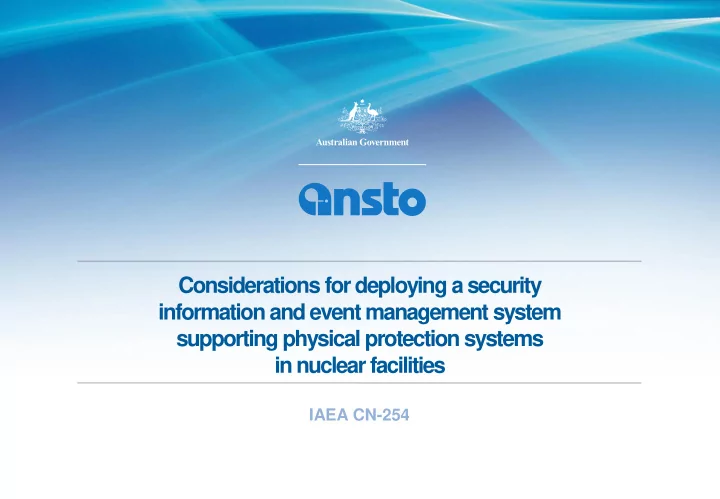

Considerations for deploying a security information and event management system supporting physical protection systems in nuclear facilities IAEA CN-254
Authors • Mitchell HEWES Australian Nuclear Science and Technology Organisation Lucas Heights, Australia Email: mitchell@ansto.gov.au • Alan COWIE Australian Nuclear Science and Technology Organisation Lucas Heights, Australia Email: ajc@ansto.gov.au
Outline • Physical Protection Systems within a Facility • Components of an ECS • Where does a CSS fit in? • Sensitive Information • Information Security Assurance • CSS monitoring a PPS • Conclusion
Terminology • PPS – Physical Protection System • ECS – Electronic Control System • CSS – Computer Security System
Physical Protection Systems within a Facility
Typical physical protection systems • Physical barriers necessitate access points e.g. doors, gates, lifts • Mechanical locks & keys • Photo identification cards & documentation • Guard personnel • Access protocols & procedures • Access log books & visitor lists
Physical Barrier & Access Point
Guard Personnel
Components of an ECS
Electronic card/token & reader
Access Controlled Door
Centralized Access Control
Computer-based components of an example networked security system.
Biometric Identification & Data
Purpose & Benefits of ECS • Greater efficiency – augment physical • Managing keys • Robust record of actions undertaken • Negate need for a guard at each door • Monitoring and recording of the state of electro mechanical components • Programmatic automation of Physical Processes e.g. Enforcement of a “no alone” zone
Where does a CSS fit in? • In our example the Computer Security System forms an overwatch function for the ECS • It would sit within a different security zone and take in inputs from multiple facility functions to be able to provide correlation for monitoring and response on attacks spanning multiple systems. • How can we enable this while protecting the function of the ECS?
Sensitive Information
Sensitive Information Automated State Change • Items used in granting automated access – Card ID – PIN Number – Biometric Templates • State information of electromechanical assets • CCTV Camera video feeds • Computer configuration • New EACS parameters supplied to make system changes Contextual State Change
Computer Security Measures for PPS • Host integrity checking • Sub zone network segregation • Netflow - record capture and parsing • Port monitoring • Port security • Wifi rogue monitoring/suppression Contextual State Change
Data Flow Model Between PPS and CSS • Sensitive information that could affect an automated state change within a facility function should not leave it’s source security zone while it is still functionally significant. • Sensitive information that could affect an automated state change within a facility function must not be generated by a system at a lower security level.
Information Security Assurance
Goals • Ensure the confidentiality, integrity, and availability of the automated operation of the PPS and the accuracy of information supplied to an operator to make contextual changes • Monitor the operation of the computer-based hardware components and software for indicators of compromise. • Provide independent computer security measures to ensure a defence in depth against a single computer security vulnerability. • Enable the response, remediation, and restoration of verifiable normal operation. Transitive from PPS: Deter, Detect, Delay, Respond
CSS Monitoring a PPS • Monitor the computer-based components of the physical protection system and the computer security measures protecting them. • Monitor the effectiveness of zone-decoupling measures for computer security zones interacting with the PPS. • Decouple from the PPS itself - limit the information flow to prevent information important to automated operation of the PPS from being captured by the CSS. E.g. through a data diode. • Provide the potential to correlate with the monitoring of other computer security zones to monitor the overall facility computer security defence in depth posture.
Conclusion
Conclusion 1. A nuclear facility PPS augmented with an ECS increases defence in depth from physical attack. 2. An ECS transfers some risk from a physical compromise to an computer-based compromise, thus the need to incorporate computer security measures to maintain defence in depth. 3. A CSS monitors computer security measures. Just as the ECS monitors the physical security measures. 4. A well thought out and implemented CSS, which preserves the confidentiality of sensitive information critical to PPS automation, is required to provide continued assurances of defence in depth.
Recommend
More recommend